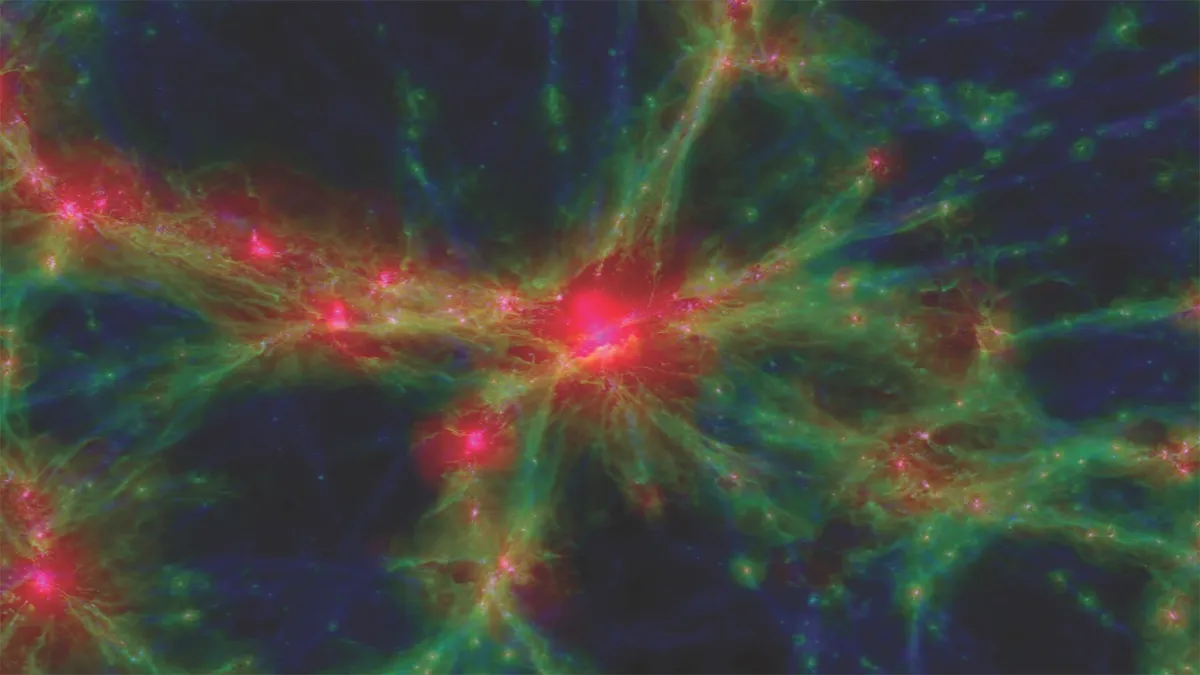Astronomy is unique among the sciences as it is conducted at a distance. Geologists can go out in the field to study rocks face-to-face and even bring them back to the laboratory for further analysis. The same goes for biologists, palaeontologists and chemists – they’re all very hands-on. But what if your area of interest lies in galaxies and how they evolved to form the structure of the known Universe? What do you do then? You can’t haul a galaxy down to Earth for closer inspection and telescopes only provides a snapshot of what they were like at for a brief moment.
For a group of astronomers based in Durham and Leiden, in the Netherlands, the answer is to build a simulateduniverse in a supercomputer. Their brainchild is the EAGLE project (Evolution and Assembly of GaLaxies and their Environments). This virtual reality universe consists of an enormous cosmological cube measuring more than 300 million light-years on each side, enough to contain around 10,000 galaxies like our own Milky Way.
To construct it, the team went right back to a time before the first galaxies, and even the first stars, formed. Three main players governed the evolution of our Universe at this time: dark matter, normal (baryonic) matter and dark energy. Dark matter acted as an invisible scaffold around which the structure of the Universe developed. Dense regions of dark matter created gravitational dimples into which more and more normal matter flowed as the Universe aged. This material was drawn together to form stars, which then coalesced to form galaxies. Dark energy is the unseen force that tries to resist dark matter’s natural desire to clump together over large distance scales.
Previous computer simulations of how the interaction between these processes form galaxies haven’t always worked. “They tended to produce galaxies that were far too big and therefore a Universe with far too many stars in,” says Prof Richard Bower, part of the EAGLE team at Durham University. So using the latest data on those three key ingredients from missions like the European Space Agency’s Planck satellite wasn’t enough, the EAGLE simulation also had to factor in the latest thinking on how galaxies evolve from youth to maturity.
Doing this required modelling how exploding stars and marauding black holes affect the development of the structure of the galaxies in which they reside. Translating all these aspects into a suitable computer code took Bower and his team three years, but the time-consuming work didn’t end there. Running that code through the DiRAC-II supercomputer to create the simulated universe took more than a month and a half of solid computing time. But the results were remarkable. “It is incredible how much a simulated galaxy in EAGLE looks like the real thing,” says Bower.
“I give talks in which it takes people five minutes to twig that they’re looking at a simulated image rather than a real one.”
Star system
An accurate computer counterpart to the real Universe is a powerful tool. You can take any galaxy and hit what Bower describes as “the big red button” to travel back in time and follow the evolution of that galaxy from its earliest days, revealing how it ended up in its present state. Theories for galaxy evolution that do not match what EAGLE shows can be discarded. It also has the ability to clear up mysteries.
When astronomers use telescopes to look at distant objects, they’re looking into the past, seeing light that has been trekking across space for billions of years to get here and bringing information about what its source was like at that time. It’s a well-established fact that the early Universe contained many red and very compact galaxies. But these red galaxies seem to have disappeared as the Universe evolved because we don’t see them any more. This vanishing act is also seen in the EAGLE simulation. Unlike with telescopes, astronomers using EAGLE can wind the clock back and keep tabs on these galaxies to see what happened to them.

It turns out that in most cases these small red galaxies merge with galaxies that are much bigger than they are. “EAGLE is telling us something important about the Universe that we couldn’t know any other way,” says Bower.
The simulation is also shedding light on a long-standing mystery surrounding the rate at which stars form in galaxies. When astronomers look out into the Universe they notice that galaxies bigger than the Milky Way have very little star formation, whereas galaxies smaller than ours seem to be making new stars at a relatively impressive rate. It has long been suspected that this has something to do with our galaxy’s central black hole. The bigger the galaxy, the more rapidly the black hole forms, which doesn’t lead to a lot of stability for star formation. In smaller galaxies, the black hole seems to grow at a more sedate pace, giving stars time to form.
Yet the reason why black holes grow faster in larger galaxies was unclear. Now, by looking at the simulated galaxies in EAGLE, researchers can see exactly what is going on. As larger galaxies contain a lot more material, gas near the centre is prevented from flowing outwards. With the rich supply of food this extra material provides, the black hole is able to gorge more effectively. “This shuts down star formation in the galaxy,” says Bower. “Understanding this process is a huge step forward in our knowledge.”
After using the simulation to travel back in time to provide some valuable insights, the team are now setting their sights on the future – using EAGLE to see what lies in store for our Universe. This is a much trickier task than going backwards, however. And to understand why, we need to return to the key players in the evolution of the Universe: dark matter and dark energy.
As the Universe has been expanding, and the galaxies have been moving further and further apart, the collective force of dark matter has been gradually dwindling. The strength of dark energy, however, has remained constant throughout the Universe’s history. This means that there came a time when the attractive strength of dark matter dropped below that of repulsive force of dark energy. At this point the expansion of the Universe began to accelerate. It is this acceleration that makes modelling the future in EAGLE difficult.
“The effect of dark energy is that it increases the computing time required to run the calculations,” says Bower. And that makes it almost a prohibitively expensive project.

However, Bower and his colleagues are hopeful they can find a way to do it. They are already working with Intel, the American computer-chip manufacturer, to incorporate their next generation of processors. If they can get the maximum efficiency out of the new chips, it should provide a tenfold increase in the speed of their calculations. Bower’s team is also looking to upgrade the supercomputers and that will lead to a further increase in the computing power at their disposal. They could then boost the size of the simulation from the 10,000 Milky Way-like galaxies it currently contains to 30,000. With a much larger set of galaxies, they could begin to do serious statistical analysis to determine how rare a galaxy like ours really is.
Crazy project
Yet Bower wants to go even further, with what he describes as his “crazy project”. He’d like to use EAGLE to see just how special our Universe is. For many years astronomers have encountered a ‘fine-tuning problem’. When you look at the fundamental constants of the Universe – the strength of gravity, the amount of dark energy and so on – everything seems eerily balanced.
Say there was more dark energy. That would have accelerated the expansion of the Universe at a much earlier time, leaving dark matter no chance to gather all the normal matter into stars and galaxies. How come with all of the values these cosmological parameters can have, they seem to be just right to give rise to a Universe capable of supporting life?
One answer is that our Universe isn’t the only one. If there were other Universes, and the parameters were set slightly different in each one, then of course we’re going to find ourselves in the Universe with the right combination for stars, galaxies, planets and people. We could hardly live in one with the wrong settings. Bower hopes to use EAGLE to discover exactly how changing these initial conditions affects how a universe turns out, once again providing an insight into how we came to be.
In many ways, the success of the EAGLE project represents a watershed moment. It marks the point at which supercomputers have become as important to astronomers as telescopes.
Follow Science Focus onTwitter,Facebook, Instagramand Flipboard
